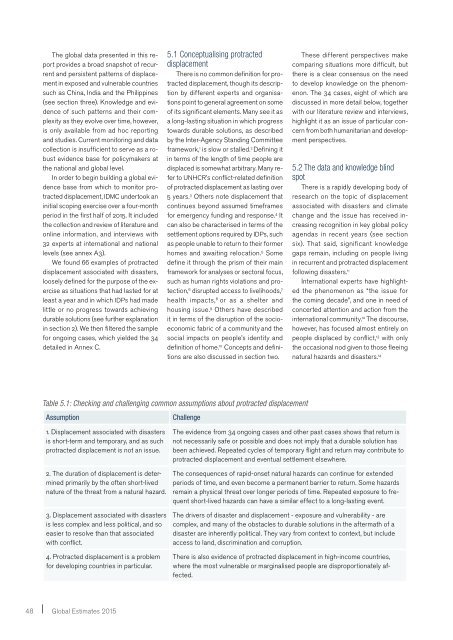Estimates
bzTPL9
bzTPL9
- No tags were found...
Create successful ePaper yourself
Turn your PDF publications into a flip-book with our unique Google optimized e-Paper software.
The global data presented in this reportprovides a broad snapshot of recurrentand persistent patterns of displacementin exposed and vulnerable countriessuch as China, India and the Philippines(see section three). Knowledge and evidenceof such patterns and their complexityas they evolve over time, however,is only available from ad hoc reportingand studies. Current monitoring and datacollection is insufficient to serve as a robustevidence base for policymakers atthe national and global level.In order to begin building a global evidencebase from which to monitor protracteddisplacement, IDMC undertook aninitial scoping exercise over a four-monthperiod in the first half of 2015. It includedthe collection and review of literature andonline information, and interviews with32 experts at international and nationallevels (see annex A3).We found 66 examples of protracteddisplacement associated with disasters,loosely defined for the purpose of the exerciseas situations that had lasted for atleast a year and in which IDPs had madelittle or no progress towards achievingdurable solutions (see further explanationin section 2). We then filtered the samplefor ongoing cases, which yielded the 34detailed in Annex C.5.1 Conceptualising protracteddisplacementThere is no common definition for protracteddisplacement, though its descriptionby different experts and organisationspoint to general agreement on someof its significant elements. Many see it asa long-lasting situation in which progresstowards durable solutions, as describedby the Inter-Agency Standing Committeeframework, 1 is slow or stalled. 2 Defining itin terms of the length of time people aredisplaced is somewhat arbitrary. Many referto UNHCR’s conflict-related definitionof protracted displacement as lasting over5 years. 3 Others note displacement thatcontinues beyond assumed timeframesfor emergency funding and response. 4 Itcan also be characterised in terms of thesettlement options required by IDPs, suchas people unable to return to their formerhomes and awaiting relocation. 5 Somedefine it through the prism of their mainframework for analyses or sectoral focus,such as human rights violations and protection,6 disrupted access to livelihoods, 7health impacts, 8 or as a shelter andhousing issue. 9 Others have describedit in terms of the disruption of the socioeconomicfabric of a community and thesocial impacts on people’s identity anddefinition of home. 10 Concepts and definitionsare also discussed in section two.These different perspectives makecomparing situations more difficult, butthere is a clear consensus on the needto develop knowledge on the phenomenon.The 34 cases, eight of which arediscussed in more detail below, togetherwith our literature review and interviews,highlight it as an issue of particular concernfrom both humanitarian and developmentperspectives.5.2 The data and knowledge blindspotThere is a rapidly developing body ofresearch on the topic of displacementassociated with disasters and climatechange and the issue has received increasingrecognition in key global policyagendas in recent years (see sectionsix). That said, significant knowledgegaps remain, including on people livingin recurrent and protracted displacementfollowing disasters. 11International experts have highlightedthe phenomenon as “the issue forthe coming decade”, and one in need ofconcerted attention and action from theinternational community. 12 The discourse,however, has focused almost entirely onpeople displaced by conflict, 13 with onlythe occasional nod given to those fleeingnatural hazards and disasters. 14Table 5.1: Checking and challenging common assumptions about protracted displacementAssumptionChallenge1. Displacement associated with disastersis short-term and temporary, and as suchprotracted displacement is not an issue.2. The duration of displacement is determinedprimarily by the often short-livednature of the threat from a natural hazard.3. Displacement associated with disastersis less complex and less political, and soeasier to resolve than that associatedwith conflict.4. Protracted displacement is a problemfor developing countries in particular.The evidence from 34 ongoing cases and other past cases shows that return isnot necessarily safe or possible and does not imply that a durable solution hasbeen achieved. Repeated cycles of temporary flight and return may contribute toprotracted displacement and eventual settlement elsewhere.The consequences of rapid-onset natural hazards can continue for extendedperiods of time, and even become a permanent barrier to return. Some hazardsremain a physical threat over longer periods of time. Repeated exposure to frequentshort-lived hazards can have a similar effect to a long-lasting event.The drivers of disaster and displacement - exposure and vulnerability - arecomplex, and many of the obstacles to durable solutions in the aftermath of adisaster are inherently political. They vary from context to context, but includeaccess to land, discrimination and corruption.There is also evidence of protracted displacement in high-income countries,where the most vulnerable or marginalised people are disproportionately affected.48 Global <strong>Estimates</strong> 2015


